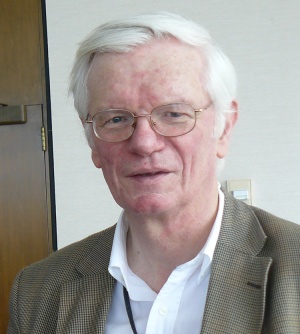David O. Morgan
David O. Morgan (1945-2019) wan an English scholar of Islamic studies.
David O. Morgan | |
|---|---|
 | |
| Born | April 29, 1945 Wales |
| Died | October 23, 2019 |
| Nationality | English |
| Occupation | Professor and Author |
BiographyEdit
David O. Morgan was born April 29, 1945 in Wales, and died on October 23, 2019 in England following complications from heart surgery. David did his PhD dissertation under the supervision of Ann K.S. Lambton (1912–2008).
EducationEdit
- bachelor at Rugby School; modern history at Worcester College, Oxford , 1966
- Doctorate at the School of Oriental and African Studies, the University of London, with a thesis on Mongol history, 1977
CareerEdit
- Taught Middle East history at SOAS ( The School of Oriental and African Studies) (1978–99).
- Taught history and religious studies at the University of Wisconsin-Madison (1999–2010)
- Taught courses over a broad chronological (600–1800) and geographical range (Middle East and Central Asia) at UW (University of Washington)
- Supervision on numerous doctoral theses at SOAS and UW
- Fully retired in 2013, taking Professor Emeritus status and returning to the United Kingdom.
- He remained active with the Royal Asiatic Society and its eminent journal, JRAS, which he had edited from 1987 to 1999.
- David was a member of the Governing Council of the British Institute of Persian Studies, the parent of the journal Iran.
PublicationsEdit
BookEdit
EditorEdit
Works on Muharram RitualsEdit
At the end of his book, Iran in Medieval Persia, translated by Abbas Mokhber into Persian, Morgan mentions in a short but analytically important paragraph the "widespread spread of Ta'ziya" in Iran in the 18th century. He went on to speak of the "suspicion of the ulema" (which, of course, is correct to say: "some ulema") to Ta'ziya, and said that the reason was the popular source of Ta'ziya and that it was outside the control of the Ulema. This characteristic and popular support prevented, according to Morgan, Ta'ziya from ever being successfully suppressed. He also referred to the political and critical function of Ta'ziya at times when there was a challenge between the state and religion.
The 18th century saw the widespread expansion of Ta'ziya. The Ta'ziyas were exhilarating plays that were especially related to the battle of Karbala (680 AD / 61 AH) in which the third Shiite Imam, Hussain, son of Ali and grandson of the Prophet, was martyred by the forces of Yazid, the Caliph of the Umayyads. The scholars were skeptical of Ta'ziya. Because it had a popular origin and was beyond their control. But it was never successfully suppressed, and in times when Shi'ism and the state clashed, it was used as an illustrative model, in which the Shah played the role of an oppressor or an agent of anti-Islamic acts, or sometimes a Yazidi.